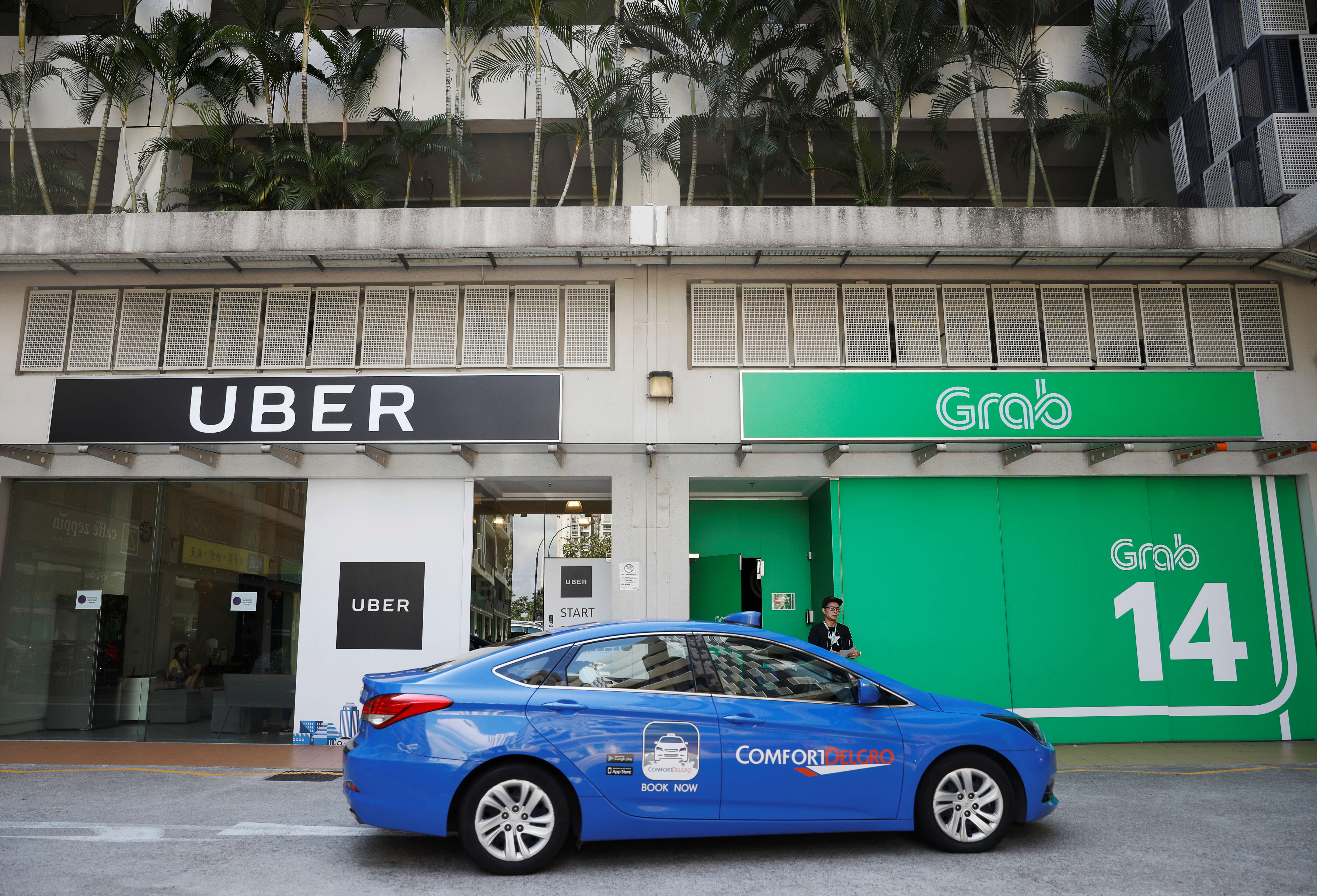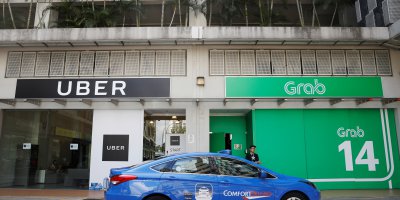
A passenger of Grab bike fixes her helmet next to Uber driver at Manggarai train station in Jakarta, Indonesia, March 26, 2018. Source: Reuters
Three takeaways from Uber’s Southeast Asia exit
THE sale of Uber’s Southeast Asia business to Grab – its regional rival – marks the end of a long-drawn and costly battle for the San Francisco-based company.
Although the deal was widely reported in the media for several weeks, the official announcement by the two companies caught some off guard: Hundreds of Uber’s staffers in Kuala Lumpur and Singapore were given two hours notice to vacate their offices and put on three-months leave pending their potential absorption into Grab. Many of Uber’s drivers, who numbered in the thousands, have also been left in the lurch.
However, Uber’s seemingly dismal financial performance as of late (losing US$4.5 billion in 2017) indicated the sale to Grab was a long time coming. Monday’s announcement, where it said it was taking a 27.5 percent stake in the combined business, also marked the third time that Uber sold or merged its business outside the US.
In Singapore alone, Uber is the latest casualty in the cutthroat ride-hailing world, after other players Hailo, Easy Taxi and Karhoo, wound up their businesses in five years. With its sale to Grab, Uber has exited eight big markets in Southeast Asia.
“In one sense, Grab has outlasted Uber. Both are probably losing money but Grab found believers in its business model and execution whose backing allowed it to go toe to toe with the larger Uber,” Nitin Pangarkar, an associate professor at NUS Business School said, as quoted by Singapore’s Business Times.
“After a fierce fight, Grab has to manage a larger organization. Equally important, it has to find a way to make money.”
And while we wait for the dust to settle, Tech Wire Asia has come up with a few takeaways as to how Uber, a global ride-hailing monolith, lost its edge in Southeast Asia.
1. Cultural advantage
While Uber poured in piles of investment in the region, Grab had the upper-hand in terms of understanding Southeast Asia’s diverse cultures. Six years into Grab’s launch in 2012, the localized ride-sharing service boasts 81 million mobile app downloads and 2.3 million drivers in 178 cities across Singapore, Indonesia, the Philippines, Malaysia, Thailand, Vietnam, Burma, and Cambodia.
According to The Wired in February, Uber has spent close to a decade figuring out what Western users want out of a ride-service, but the company has struggled to adapt its findings in emerging markets like Southeast Asia. Grab, on the other hand, managed to make e-pay work in nations that lacked financial infrastructure.
While Grab succeeded in gaining non-tech inclined customers, Uber did not manage to come up a strategy that prevented it from coming across as an old-school colonial power. Instead, it may have imposing its high-tech systems and flaky ideologies from above on populations which are quite capable of growing their own, more sympathetic and cheaper versions, as pointed out in a previous Tech Wire Asia article.
Additionally, Grab’s decisions to install in-cab CCTV and feature live journey-tracking have allayed many concerns of lone female passengers – especially those riding while browsing the news on-the-go about Uber’s apparent culture of sexism and harassment.

A ComfortDelgro taxi passes Uber and Grab offices in Singapore March 26, 2018. Source: Reuters/Edgar Su
2. Cash payments
It took Uber some two years before it began accepting cash payments in some parts of the region. Before that, payments to Uber were done only by credit card, a feature which turns off the sizable number of riders who want to pay cash or prepay.
Even when Uber’s one-size-fits-all app was customized for local markets, the company trailed behind Grab’s app which showed a deeper understanding of its drivers and riders needs. When Grab started in the Philippines and Vietnam, it showed many how to use smartphones and its app. Grab also found that most potential riders did not have credit cards, so it accepted cash.
3. Late to the food delivery party
Even in its meal-delivery services, Uber Eats struggled to compete with a number of its smaller, regional competitors.
In Bangkok, Thailand, one of Southeast Asia’s most populated cities with 10 million people, Uber Eats faced stiff competition from Foodpanda, Line Corp.’s Line Man, and Grab Food.
By the time Uber Eats set up shop in Bangkok in 2017, Foodpanda had already been running with a five-year head start.
To woo customers, the food delivery companies spoiled them with free delivery and discount offers which considerably reduced their profits.
Foodpanda’s Thailand Chief Executive Alexander Felde recently told Bloomberg that the industry’s current approach of “throwing money at customers” can’t last long term, and some rivals are well funded and could spark a “crazy war” for market share.
Foodpanda started in Bangkok, a city of some 10 million people, in 2012 and made the vast bulk of its sales in the capital. The Thai business has already broken even, but margins are under pressure, Felde said.
While the industry’s current approach of “throwing money at customers” can’t last long-term, Felde said some rivals are well funded and could spark a “crazy war” for market share.
READ MORE
- The criticality of endpoint management in cybersecurity and operations
- Ethical AI: The renewed importance of safeguarding data and customer privacy in Generative AI applications
- How Japan balances AI-driven opportunities with cybersecurity needs
- Deploying SASE: Benchmarking your approach
- Insurance everywhere all at once: the digital transformation of the APAC insurance industry




